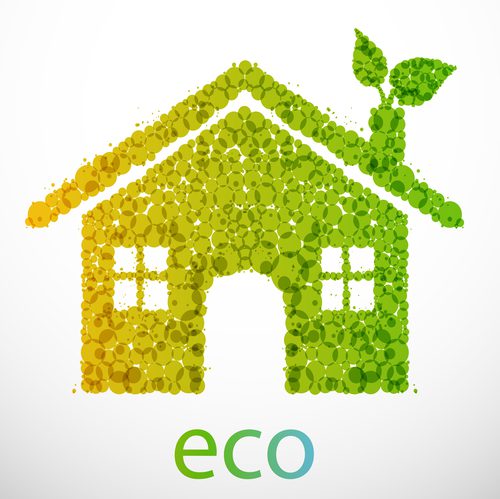At Home
- Change your light bulbs. Swap out incandescents with compact fluorescents (CFLs). Replace the five most frequently used conventional light bulbs with Energy Star rated ones and you’ll save approximately $100/yr. CO2 emission reductions: 120 lbs/bulb/yr
- Turn off incandescent light bulbs when leaving a room. CO2 emission reductions: 89 lbs/yr
- Buy energy-efficient appliances. Energy Star appliances use 10 to 50% less energy and water than traditional products. CO2 emission reductions: dishwasher – 340 lbs/yr, refrigerator – 780 lbs/yr and washing machine – 1,200 lbs/yr
- Use a microwave instead of a conventional oven to reheat small quantities of food. CO2 emission reductions: 1 lb/meal
- Use passive solar to capture heat in your home by opening the curtains during the day, and closing them at dusk. In the summer, keep curtains closed during the hottest hours of the day. Besides carbon, you’ll save 25–75% on you heating and cooling bills. CO2 emission reductions: 2,700 lbs/yr
- Adjust your thermostat down 2°F in winter and up 2°F in the summer and you’ll save approximately $100/yr. CO2 emission reductions: 420 lbs/yr
- Set your water heater at 120°F. CO2 emission reductions: electric water heater – 1,200 lbs/yr and natural gas – 880 lbs/yr
- Replace exterior lights around your home with solar powered ones. CO2 emission reductions: 110 lbs/yr
- Clean your air filters regularly and have your heating and cooling equipment tuned annually. CO2 emission reductions: 350 lbs/yr
- Run your ceiling fans instead of AC. CO2 emission reductions: 2,700 lbs/yr
- Buy green power or ask your utility to offer it. The typical U.S. home consumes ~10,000 kilowatt-hours/year. Using electricity that is generated from renewable energy sources such as wind and the sun could reduce the annual CO2 emissions by 22,000 lbs.
- Use a low flow showerhead. CO2 emission reductions: electric – 1,800 lbs/yr and natural gas – 430 lbs/yr
- Reduce, Reuse, and Recycle items such as: newspapers, beverage containers, paper and other goods. This reduces pollution from resource extraction, manufacturing, and disposal. CO2 emission reductions: 1,300 lbs/yr
- Use cold water to wash and rinse clothes, instead of hot or warm water. You’ll save ~0.50 cents/load. CO2 emission reductions: 27 lbs/yr
- Plant trees to provide shade and wind protection for your house. Cooling and heating savings 2-18% depending on the location and size of the tree. CO2 emission reductions: 35-800 lbs/yr (dependent on the size)
- Push an electric mower or better yet a reel mower rather than a gas model. CO2 emission reductions: 80 lbs/yr. If you do use a power mower, make sure it’s a mulching mower to reduce grass clippings sent to landfills.
- Hang laundry to dry. CO2 emission reductions: 4 lbs/yr/load
- Use rechargeable (lithium-ion batteries) instead of standard AA or AAA batteries to power small electronics. CO2 emission reductions: 450 lbs/yr
- Say no to carpeting your home. CO2 emission reductions: 4,000 lbs/800 sq. ft.
- Consume less meat and buy local produce. It takes energy to raise, farm, ship, and sell livestock. CO2 emission reductions: 1.5 tons/yr
At the Office
- Activate the power management features on your computer and monitor. Unplug laptops and turn off equipment and lights at the end of the day.
- Purchase ENERGY STAR qualified office equipment, such as computers, copiers, and printers, as well as lighting, heating and cooling equipment. These products use 30-75% less electricity.
- Obtain ENERGY STAR certification for your office building. ENERGY STAR-labeled buildings use about 35 percent less energy than traditional buildings.
- Use recycled paper (100% post-consumer). CO2 emission reductions: 6 lbs/ream
- Telecommute. CO2 emission reductions: 5,700 lbs/yr
- Use a laptop, not a desktop. Laptops use up to 80% less energy. CO2 emission reductions: 400 lbs/yr
On The Road
- Buy Smart – before buying or renting a vehicle, check out EPA’s Green Vehicle Guide at: www.epa.gov/greenvehicle. This resource provides information on emissions, fuel economy, and performance.
- Drive Smart — to improve fuel economy and reduce emissions, accelerate gradually and drive the speed limit. CO2 emission reductions: 250 lbs/yr
- Use cruise control on the highway: CO2 emission reductions: 100 lbs/yr
- Combine errands into one trip and save 500 miles of driving/yr. CO2 emission reductions: 510 lbs/yr
- Lighten your load. 100 pounds of junk in the trunk can reduce gas mileage by 2%. CO2 emission reductions: 10 lbs/yr
- Check your air filter monthly and replace it when it looks dirty. CO2 emission reductions: 800 lbs/yr
- Keep tires properly inflated. Under-inflated tires increase tire wear, reduce fuel economy by up to 3%, and emit more pollutants into the air. CO2 emission reductions: 100 lbs/yr
- Use your AC sparingly, or not at all. CO2 emission reductions: sparingly – 100 lbs/yr and never – 600 lbs/yr
- Don’t idle for more than 10 seconds; instead, turn off your engine. CO2 emission reductions: 500 lbs/10 non-idling minutes
- Carpool or bus or ride your bike to work instead of driving besides saving you money you’ll also help the environment. CO2 emission reductions: carpool – 500 lbs/yr, bus – 690 lbs/yr and bike – 2,220 lbs/yr
- Remove your roof rack when you’re not using it; a rack can reduce fuel efficiency by 5%. CO2 emission reductions: 250 lbs/yr
- Consider using renewable fuels. Use biodiesel or ethanol to fuel your vehicle or drive a hybrid. CO2 emission reductions: 50 lbs/100 miles driven.
SOURCE: Orange County’s ORANGE to GREEN website.

